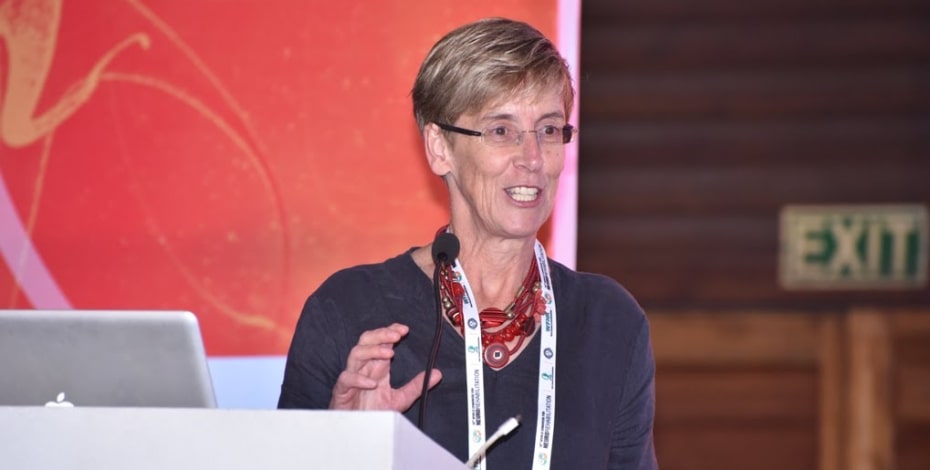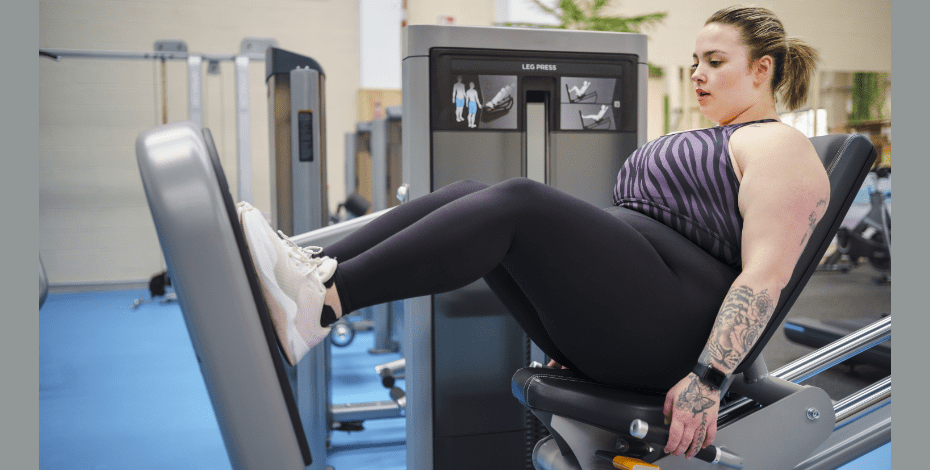
Education the backbone for spinal cord injury researcher

Lisa Harvey has made a huge impact in advancing the treatment of people with spinal cord injuries and other disabilities. So how does this clinician, educator, researcher, mother and wife manage it all?
As a child, Lisa Harvey was a keen swimmer and she became fascinated by the biomechanics of how you could swim if you didn’t have the use of your legs. Then her thoughts drifted to wondering about how a person could swim if they had paralysed legs. While not a driving force behind what was to become her career in physiotherapy practice and then in research, that questioning as a child was certainly an influence.
As a young woman, the talented cellist had also seriously considered making music her profession. Having grown up in a musical family, Lisa’s childhood was ‘all about the music’ and she faced the tough decision to choose between becoming a professional cellist or studying physiotherapy. ‘I’m mighty glad I didn’t become a musician,’ Lisa says. ‘The world of academia is pretty cutthroat and competitive, but the world of a musician is even more so.’
After completing her degree at the then- Cumberland College of Health Sciences in Sydney in 1984, Lisa, APAM, began to pursue her passion to work in spinal cord injuries with vigour. As a new graduate Lisa started out at Prince Henry Hospital in Little Bay, and during her first year on rotation she began working with amputees and patients with spinal cord injuries. As the only facility offering this to first-year graduates, Prince Henry Hospital was where Lisa stayed. She threw herself into her work and within nine months of rotating into spinal cord injuries, all the senior staff left. Lisa found herself as ‘the last man standing’.
‘That was a very steep learning curve, I was basically teaching myself,’ Lisa says. ‘I think that set me up for realising that you can’t just get out of physiotherapy school and know how to treat a person with spinal injuries. I discovered there were very few resources to help me, so that set me on the path to get really interested in education and in training. This experience actually led me to go on in later years to write a textbook about physiotherapy management of people with spinal cord injuries. I felt I had a really good understanding of what young physios do and do not know, and what they need to know.
‘I had always wanted to do spinal cord injuries. Always. That’s really why I went into physiotherapy. But there was a period when I was thinking about amputees also. I think this reflects my fairly concrete thinking; it’s so clear what the disability is so it’s logical what needs to be done—there are not the same sort of ambiguities that there are in perhaps some other areas of physiotherapy,’ Lisa says.
Lisa vividly remembers an encounter in her first year that stays with her to this day. While she has since seen too many patients to count, as a young physiotherapist she encountered two patients who arrived at the hospital around the same time, both with life-changing injuries.
‘These patients were only about three years younger than me, both had football injuries. They were both agricultural students, both at university, so I guess they were people that I could really relate to,’ Lisa says. ‘These two people really stick in my mind. They had quite high levels of tetraplegia. But you know, I’ve watched from a distance what they’ve gone on to do with their lives, and they’ve done amazing things. I think their lives are really inspiring.’
In the two decades Lisa subsequently spent working as a senior physiotherapist in the Prince Henry Spinal Unit she saw many tragedies but, equally, many triumphs. While many patients may not have recovered physically, most learned to make the best of their disabilities and go on to create successful, productive lives for themselves. This, Lisa says, proved inspiring in a field that most practitioners and allied health workers may consider to be professionally rewarding but emotionally challenging.
‘Anyone who sustains a spinal cord injury… they’ve got so many challenges and difficulties to face, and they all face them in different ways. They’re all inspiring in different ways,’ Lisa says.
In her role at the hospital, Lisa also shared her passion for learning. She taught graduate and undergraduate physiotherapists, held staff in-services and embarked on her first foray into research. From the late 1980s she began lecturing about spinal cord injuries on the physiotherapy undergraduate, and later postgradulate, programs at the University of Sydney, and then at other universities in Sydney and New South Wales.
Postgraduate study also became an important part of Lisa’s life; she completed her graduate diploma in exercise and sports science in 1992 and her master’s in 1994. That same year Lisa became the project coordinator and coinvestigator for the ‘Walkagain’ project, funded by the NSW Motor Accidents Authority.
It was in 1997 that Lisa decided to pursue a PhD through the University of Sydney, writing her thesis on contracture management in people with spinal cord injury. Following her PhD Lisa did some consultancy work for a US-based company called Clinical Assistance Programs. This involved training 23 sites across Australia, New Zealand, India and the UK for a large multi-centred clinical trial designed to determine the effectiveness of a drug for people with spinal cord injuries.
‘I saw a lot of airports and hospitals all over India during this job, and I started to get a better understanding of healthcare systems in different countries. This work opened the door to get me involved in the International Spinal Cord Society (ISCOS), which has a very strong commitment to training and education everywhere. And so because of that, I got put in charge of the education committee of ISCOS. I was responsible for organising education in various places around the world and for running training courses for physios and spinal injuries. It was a wonderful opportunity and took me to places all over the world to teach about spinal cord injuries,’ Lisa says.
‘One thing led to another and before I knew it, Jo Glinsky [a colleague] and I were very involved in an initiative from ICOS to develop online training modules for students and junior clinicians working in the area of spinal cord injuries (elearnSCI.org). The training modules are for…the whole team, so not just physios. However, the physio module that Jo and I were responsible for was very much targeted at physios, new physios and students, who didn’t have any exposure to people with spinal cord injuries. It was aimed at helping in places where physios don’t have anyone to teach them about spinal cord injuries.’
Lisa and Jo then began running online courses, the second and third of which were oversubscribed to the point where the pair had to close registrations. ‘We thought maybe we’d get 100 people that would be interested. We got 10,000 and we had to close registrations because we couldn’t deal with any more,’ Lisa says. ‘And then we did it two years later and we got even more, so again we had to cap registrations. It doesn’t speak to us, it speaks to the fact that the world’s a big place and in some countries, spinal cord injuries are much, much more common than here.
‘We’re talking about all over Asia and Africa. War-torn countries. Countries with low occupational health and safety standards. There’s huge numbers of spinal injuries and fantastic physios everywhere who really want to do a good job. But they do suffer from lack of support. It’s very humbling to help them…but what’s really motivating is all these young, keen physios all over the world who really want to do the right thing by their patients. They really care.’
Of her many, many achievements professionally, Lisa counts the advent of physiotherapyexercises.com as among her top. This is free online software that enables physiotherapists to prescribe exercises for people with spinal cord injuries and other disabilities. She also credits her funder, the NSW state regulatory body, icare, which has afforded her the luxury of ‘the freedom to move in these directions. They’ve given me support and time to take on these initiatives without the usual pressures that academics face to publish, publish, publish…’ she says.
Presently, Lisa is doing a lot of work in collaboration with colleagues in Bangladesh and she has a ‘large NHMRC-funded trial’ that is just about to finish. ‘This is looking at trying to prevent premature death in people with spinal cord injuries in lower and middle income countries.
‘I love working with my colleagues from some of these countries, helping them do research to try and find solutions for their problems, because if you think public health and you think about the big world and you think about spinal cord injuries, then the big picture problem is trying to stop these patients from developing complications and dying when they are sent home,’ Lisa says. ‘So there’s really big pressing issues in these countries and in actual fact, in a lot of these countries, the physios are going to be the solution.’
Lisa, a professor at The University of Sydney, continues her work while raising her two children, Dan and Jem, with her physiotherapist researcher husband, Rob. Juggling her many and varied roles has been made possible by having a supportive partner and by understanding that it is not possible to effectively take on all tasks without sacrificing something else.
‘I think having a very supportive husband helped me enormously. You’ve got to have a husband who’s a feminist, that really believes in 50/50,’ Lisa says. ‘And I think also, something has to give. I have two very beautiful children but I think they largely brought themselves up. They are more the produce of good luck than good parental management. You’ve got to balance it all, and as a working mum doing all these things you need to realise that you’re never going to be the same as a stay-at-home mum/dad. You’ve got to come to terms with that.’
© Copyright 2024 by Australian Physiotherapy Association. All rights reserved.






